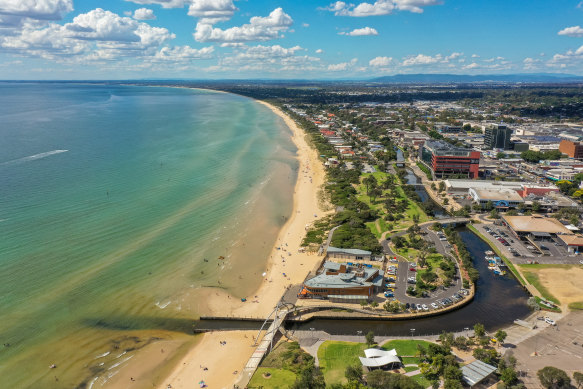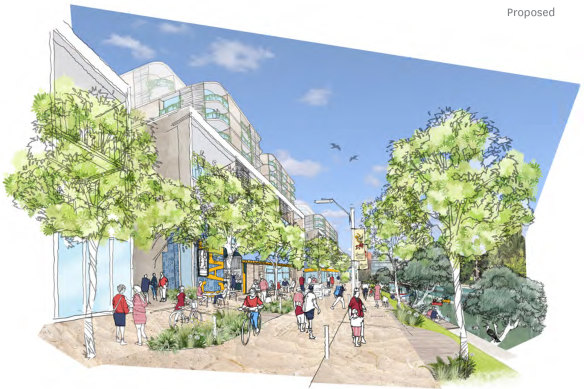Melbourne’s floodplain authority has objected to the long-awaited masterplan for the redevelopment of Frankston’s city centre – which includes building highrises near the beach – because it does not acknowledge flood risk or coastal inundation caused by rising sea levels.
The masterplan has become a lightning rod of debate in Frankston because it encourages developing 12-storey apartment buildings that are dubbed by detractors the Great Wall of Frankston but promoted by supporters as an economic boon for the seaside suburb.

Long Island, a narrow stretch of land between Kananook Creek and Frankston Beach, is at the centre of a campaign against two proposed apartment towers.Credit: Justin McManus
Hundreds of community submissions on the new plan led Frankston Council to refer the entire matter to an independent planning panel last week.
The plan is being thrashed out while two highrise apartment buildings overlooking Frankston Beach are already awaiting a decision on permit approval at the Victorian Civil and Administrative Tribunal.
In its submission to the council plan, Melbourne Water said it could not endorse the strategic document as it ignored the risks of flooding in areas earmarked for new developments.
“It appears the Frankston Metropolitan Activity Centre Structure Plan (June 2023) makes no reference to flooding, coastal inundation or the special building overlay/land subject to inundation overlay (LSIO),” the water authority said.

An artist’s impression in the Frankston Metropolitan Activity Centre Structure Plan of proposed development along Kananook Creek Boulevard. Credit: Frankston City Council
“While you might not expect it to fully address flood issues, the fact that there is no mention at all is concerning, particularly given ongoing impacts of climate change and sea level rise.”
Melbourne Water’s role in approving developments in flood-prone areas came under intense scrutiny following the October 2022 Maribyrnong floods in which more than 600 properties in Melbourne’s west were inundated after the Maribyrnong River burst its banks.
Since then, advice from the floodplain authority has led the Bass Coast Shire council to knock back permits for housing developments in low-lying areas.
Frankston has long been earmarked in government plans as an area that requires a greater density of housing in its downtown area. Last year, it was named again as one of 10 activity centres in Victoria’s Housing Statement that are singled out to absorb more residential development than other areas.
Residential development plans along one 300-metre derelict stretch between Kananook Creek Boulevard and the Nepean Highway have become fiercely political and split the community over the past year.
Referencing the proposed planning controls along the Kananook Creek promenade, Melbourne Water warned access could be cut off by floodwaters in a one-in-100-year flood.
It said illustrations in the structure plan showing cafes and restaurants at street level alongside Kananook Creek could be “misleading” to developers as ground floors of any new development facing the creek would probably need to be raised substantially higher to avoid flooding risks.
The water authority also warned that some properties facing the creek would be cut off in the event of a one-in-100-year flood and also discouraged proposed increased density in some parts of inner Frankston in pondage areas, labelling it “unsafe”.
“Proposals which also increase density and impervious surfaces in the Frankston Metropolitan Activity Centre Structure Plan are likely to exacerbate flooding to the immediate downstream catchment as well as within the activity centre pondage area, and as such would not be supported by Melbourne Water,” it said.
Frankston City Council would also have to prove the health of Kananook Creek would not be compromised by overshadowing new residential buildings before Melbourne Water would endorse the plan, the submission said.
Melbourne Water is working with all metropolitan councils including Frankston to undertake new flood modelling based on new expectations for sea level rises by 2100, but the modelling won’t be complete until mid-2025.
The council voted to endorse the Frankston development plan last June, but it still needs formal approval from Planning Minister Sonya Kilkenny.
The water authority recommended Frankston council defer the plan until the results of the new flood modelling are known.
But the council is moving ahead with the process and said it would now be up to an independent panel to consider the more than 400 submissions received about the plan – including from Melbourne Water – before it eventually goes to the minister for final approval.
In response to questions from The Age, Mayor Nathan Conroy said flood overlays were referenced in other key council strategy documents and that it was unnecessary to hold up the plan for new flood mapping because, “it is not possible to hold work, as studies and modelling are always being undertaken on a range of different matters and are not always implemented and made legislation”.
At a council meeting last Monday, independent councillor Claire Harvey said she was alarmed by Melbourne Water’s submission and hoped an independent panel would take the matters seriously.
“Change will keep coming, and I’m not convinced that we’ve laid down appropriate principles for navigating the complex terrain of climate risk, the very real potential of associated liability for future losses, and these could be extraordinary,” she said.
“I can’t not take this advice seriously as it loads unnecessary risk and liability and costs upon future councils and future ratepayers, which is unfair and unconscionable.”
Meanwhile, applications for two apartment buildings – 16-storey and 14-storey developments – along the Kananook Creek Boulevard stretch are already well-progressed and awaiting an outcome from VCAT.
Both were submitted to the council under the current structure plan, which has a preferred height limit of 32 metres, or about eight storeys.
One of the developments, at a low-lying site at 438-444 Nepean Highway, has an inundation overlay, which means it is subject to future flood risk and as such was referred to Melbourne Water for approval, which it granted with conditions.
But the neighbouring development site at 446-450 Nepean Highway, where the ground level is higher, does not have a flooding overlay and therefore was not referred to Melbourne Water.
The planning minister’s office was asked by The Age if the minister was concerned by the issues raised by Melbourne Water given the outcomes for both developments would probably occur before the new Frankston plan had been through the independent panel and formally adopted into the planning scheme.
“There are planning controls currently in place in Frankston that apply to land subject to flooding risk, which must be considered when assessing planning applications,” a state government spokesperson said.
The VCAT hearings ground to a halt last year when Kilkenny made a surprise last-minute intervention temporarily limiting building heights along the strip to three storeys.
But that position was overturned three months later when she placed a preferred height limit on the strip of 12-storey developments, using the justification that those were the height limits in the forthcoming council structure plan.
The Morning Edition newsletter is our guide to the day’s most important and interesting stories, analysis and insights. Sign up here.